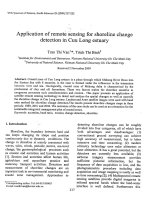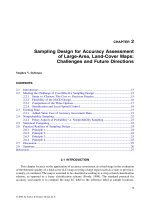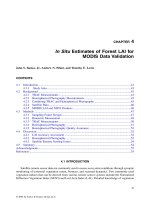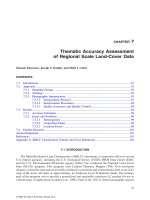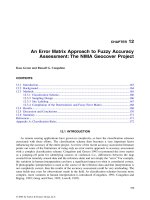Application of remote sensing and GIS on landslide
Bạn đang xem bản rút gọn của tài liệu. Xem và tải ngay bản đầy đủ của tài liệu tại đây (1.61 MB, 55 trang )
THAI NGUYEN UNIVERSITY
UNIVERSITY OF AGRICULTURAL AND FORESTRY
NGUYEN KIEU ANH
APPLICATION OF REMOTE SENSING AND GIS ON
LANDSLIDE RISK IN PAC NAM DISTRICT, BAC KAN
PROVINCE
THESIS PROPOSAL
Study Mode: Full-time
Major
: Environmental Science and Management
Faculty
: International Program Office
Batch
: 2015-2019
Thai Nguyen, 09/2019
DOCUMENTATION PAGE WITH ABSTRACT
Thai Nguyen University of Agriculture and Forestry
Degree Program
Bachelor of Environmental Science and Management
Student name
Nguyen Kieu Anh
Student ID
DTN1554290001
Thesis Title
Application of remote sensing and GIS on landslide
Supervisor (s)
risk inNguyen
Pac Nam
district,
Msc.
Van
Hieu Bac Kan province
Supervisor’s
Signature
Abstract:
Pac Nam district is a mountainous district in Bac Kan province located in
the North Eastern part of Vietnam. Landslides occur frequently in this area
and seriously affect local living conditions. Especially, three households
comprising 13 persons died in 2009 due to a landslide in Khen Len village of
Cong Bang commune, Pac Nam district, Bac Kan province. Hence, the
analysis of landslide risk in this area is an important topic for both
administrators and the local inhabitants. In this study, landslide factor maps
incorporating factors such as slope, rainfall, geological fault, soil types, traffic,
land cover and distance to roads were used as input data to create a landslide
risk map in Pac Nam district, Bac Kan province. A weight number estimation
method for landslide risk was applied to the study area in order to create the
landslide risk map. The final map indicates that medium, high and very high
landslide risk zones are distributed in the Northwest and Northeast areas of
Pac Nam including six communes: Nhan Mon, Bang Thanh, Cong Bang, Giao
Hieu and Boc Bo. The total area of high, very high and medium landslide
areas accounts for about 57% of Pac Nam and the area of the medium risk of
landslide regions is the largest compared to the remaining areas with about
40% of the district area. The low risk area for landslides accounts for 43% of
Pac Nam area, completely distributed in the Southeast and Southwest of this
district in five communes: Co Linh, Xuan La, Cao Thang, Nghien Loan and
Cao Tan.
i
Keywords
Geographic Information System, Landslide, Pac Nam
Number of pages 55
Date of submission 23/09/2019
ii
ACKNOWLEDGEMENT
Approved by the Advanced Education Program – Thai Nguyen University
of Agriculture and Forestry, I have successfully conducted the research:
―Application of remote sensing and GIS on landslide risk in Pac Nam district‖.
First and foremost, I would like to thank my research supervisor, Msc. Nguyen
Van Hieu – director of ―GeoInformatics Research Center‖ and Mr. Mui Minh
Tung, who helped me a lot during the internship time. Without the assistance and
dedicated involvement in every step throughout the process, this research would
have never been accomplished.
I also would like to show gratitude to the staff members of GIRC, who
helped and supported me to accomplish my research. In addition, I would like to
thank my family and my friends by always staying by my side, encourage and
help me in learning and researching.
Thai Nguyen, September 14, 2019
Student
Nguyen Kieu Anh
iii
TABLE OF CONTENT
DOCUMENTATION PAGE WITH ABSTRACT ................................................. i
ACKNOWLEDGEMENT ..................................................................................... iii
TABLE OF CONTENT ........................................................................................ iv
List of Figures ......................................................................................................... 1
List of Tables .......................................................................................................... 2
List of Abbreviations .............................................................................................. 3
PART I. INTRODUCTION ................................................................................. 4
1.1. Research rationale ........................................................................................... 4
1.2. Research objectives ......................................................................................... 6
1.3. Research questions .......................................................................................... 6
1.4. Limitations ....................................................................................................... 6
PART II. LITERATURE REVIEW ................................................................... 7
2.1. Theoretical basis .............................................................................................. 7
2.1.1 Landslide definition ....................................................................................... 7
2.2.2. Application of GIS on landslide analysis in Vietnam ................................ 12
PART III. METHODS........................................................................................ 14
3.1. Material .......................................................................................................... 14
3.2. Methods ......................................................................................................... 14
3.2.1. Data collection and analysis ....................................................................... 14
3.2.2. Inheritance method ..................................................................................... 19
3.2.3. Multi-criteria analysis (MCA) method ....................................................... 19
3.2.4. Map editing method .................................................................................... 21
PART IV. RESULTS .......................................................................................... 23
iv
4.1. Natural and socioeconomic condition assessment in Pac Nam district, Bac
Kan province......................................................................................................... 23
4.1.1. Natural condition ........................................................................................ 23
4.1.2. Social and economic conditions ................................................................. 25
4.2. Calculating the weight number for landslide estimation ............................... 27
4.3. Landslide risk assessment.............................................................................. 29
4.4. Building the landslide risk map in Pac Nam district, Bac Kan province ...... 30
4.4.1. Impact of terrain slope on landslide: .......................................................... 30
4.4.2. Impact of traffic on landslide. .................................................................... 32
4.4.3. Impact of geological fault on landslide. ..................................................... 34
4.4.4. Impact of land use on landslide: ................................................................. 36
4.4.5. Impact of rainfall on landslide .................................................................... 37
4.4.6. Impact of soil types on landslide ................................................................ 39
4.4.7. Mapping landslide risk in Pac Nam district ............................................... 42
PART V. DISCUSSION AND CONCLUSION ............................................... 44
5.1. Consequences of landslide ............................................................................ 44
5.2. Main reasons of landslide in Pac Nam .......................................................... 45
5.3. Landslide preventions .................................................................................... 46
REFERENCES ................................................................................................... 48
v
LIST OF FIGURES
Figure 3.1. The photo frame picture................................................................ 21
Figure 4.1. The administrative map of Pac Nam district, Bac Kan province . 23
Figure 4.2. The slope map of Pac Nam district ............................................... 30
Figure 4.3. The traffic map of Pac Nam district ............................................. 32
Figure 4.4. The geological fault in Pac Nam district ...................................... 34
Figure 4.5. The land cover map of Pac Nam district ...................................... 37
Figure 4.6. The rainfall map of Pac Nam district............................................ 39
Figure 4.7. The soil types map of Pac Nam district ........................................ 41
Figure 4.8. The landslide risk map in Pac Nam district, Bac Kan province ... 42
1
LIST OF TABLES
Table 4.1. The weight number estimation ................................................................ 28
2
LIST OF ABBREVIATIONS
CAD
Computer-aided design
DMBS
Database Management System
GIS
Geographic information system
GPS
Global Positioning System
PDA
Personal digital assistant
3
PART I. INTRODUCTION
1.1. Research rationale
Bac Kan is located in a northern mountainous region of Vietnam. Most of
Bac Kan’s surface are mountains and hills, accompanied by a complicated
network of streams and rivers. Due to this rugged and forested topography, the
development of water resources has been limited resulting in exploitation of Bac
Kan’s forest resources; this has caused degradation of the forests. The climatic
condition of the province is typically tropical monsoonal, the rainy season is
from May to October accounting for about 88-90% of the annual rainfall and dry
season lasts 5 months between November and April leading to water shortage
conditions during these months. With the topography of high steep hills and
mountains, Bac Kan always has the risk of land and stone landslides, seriously
affecting local living conditions, especially when the leveling of houses is still
arbitrary. The province has about 300 spots with more than 2,000 households
located in high risk of landslides, while the rainy season is still long. Most
families living in this area are not safe due to insufficient investment in
infrastructure and high ta-luy roofs, causing potential risk for landslides.
The topographical characteristics of Pac Nam are gradually rising from the
Southeast to the Northwest, created by large mountain ranges that have the
direction of Southeast - Northwest. The district has three main stream branches,
one of the watersheds of the Nang River. The terrain is quite complex but can be
divided into 2 large regions: High and low areas. The highlands have an average
height of over 800 m or more, accounting for about 60% of the whole district
area. This region is sparsely populated, has potentials for land, forestry and
4
minerals, and is capable of mobilizing into socio-economic development. The
lowlands have elevation below 800 m, mainly low mountainous terrain, valley
basin, accounting for about 40% of the natural area of the district. Pac Nam is
one of the upland districts of Bac Kan province, every year this district is
affected by local floods and whirlwinds. With specific features of hilly terrain,
large slope and many streams, along with relatively high average annual rainfall,
in recent years, Pac Nam district has been suffered from many flash floods and
landslides during the rainy season. Particularly in 2015 and 2016, Pac Nam
district is one of the localities that suffered heavy losses of the province from
natural disasters caused by floods, which caused roofs of many houses, many
hectares of cash crops and forests of people were collapsed, a number of roads
with serious erosion, damaging up to more than 10 billion. According to statistics
of Pac Nam district, in the rainy season in 2019, the whole district still has more
than 200 locations at risk of the effects of flash floods and landslides scattered in
40 villages of 10 communes. The total number of households at risk of landslides
is 268, flash floods and inundation nearly 80 households, households in disasterprone areas mainly concentrated in Nhan Mon commune, Bang Thanh, Co Linh
and An Thang communes.
In recent years, with the development of information technology, there are
many researches towards the application of remote sensing technology and
GIS. The GIS tool here is used to assess the relationship between landslide
factors by developing a landslide factor map. These factors are classified into
different classes in accordance with its influence on landslide. Integrated
landslide factor maps are weighted together to estimate the landslide risk. For
5
reasons mentioned above, I selected the topic: ―Application of remote sensing
and GIS on landslide risk in Pac Nam district, Bac Kan province‖
1.2. Research objectives
Using GIS, remote sensing, research, assessment and zoning of landslide
risk to determine the hazard level of the landslide from sampling spot and find
out reasonable solutions to minimize the adverse effects of landslide on human
life in Pac Nam district, Bac Kan province.
1.3. Research questions
This study was conducted to answer the following research questions:
1) What are the main causes of landslides in Pac Nam district, Bac Kan
province?
2) What are the effects of landslide?
3) What are methods to determine landslide risk?
4) How can we reduce the landslides in Pac Nam district, Bac Kan
province?
1.4. Limitations
This study might have a high cost to go to the popular site and also for the
methodological preparation. Due to insufficient money, we have to use landset
images that free in the Internet and they have poor quality.
6
PART II. LITERATURE REVIEW
2.1. Theoretical basis
2.1.1 Landslide definition
The Glossary of Geology (Bates and Jackson, 1987) defined a landslide as
"...the downslope transport under gravitational influence of soil and rock material
en masse. Usually the displaced material moves over a relatively confined zone
or surface of shear". This definition can be simplified by removing the qualifying
sentence and translating all of what remains into less pretentious English.
The causes of a landslide can be divided into three categories namely
morphology, human activity, and geology. Morphology is related to the structure
of the earth surface. Sloppy land can lose vegetation due to a drought or fire
which causes it to become vulnerable to a landslip when the root system that
holds soil intact is destroyed. The saturation of the earth by melting snow,
glaciers, or even the occurrence of heavy rainfall can cause a landslide. The
second cause of landslides is human actions on land. Deforestation, water
leakage, rock blasting, vibrations by machinery, and excavations are major
causes. The third cause of landslides is geology which refers to the characteristics
of the soil material itself. The earth might be fractured and weak either on the
surface or underneath. Different layers of the earth may possess different
stiffness, strengths, and water permeability ability. Certain layers may be prone
to a landslide in case of an earthquake or heavy rainfall. Volcanic eruptions are
another risk (Daniel Maina Wambugu, 2018).
Landslides pose a permanent hazard to the lives and livelihoods of people
in most parts of the world, especially in areas with rapid population and
7
economic growth. The hazards are mitigated primarily through preventive
measures - for example, by limiting or even eliminating populations from
landslide history, by limiting certain types of uses. The soil has a problem of
slope stability and by installing early warning systems based on monitoring of
ground conditions such as soil and rock stress, shifting of slope and groundwater
level. There are also many different direct methods to prevent landslides;
including modifying slope shape, using chemical agents to reinforce slope
materials, installing structures such as piles and retaining walls, mortar and
cracks, diverting debris, and drainage surfaces water and underwater drainage.
Such direct methods are limited by the cost, intensity and frequency of
landslides, and the size of human settlements at risk (Xingmin Feng, 1998).
2.1.2. GEOGRAPHIC INFORMATION SYSTEM (GIS)
There are many definitions of geographic information systems (GIS):
There are many definitions of geographic information systems (GIS):
- A collection of hardware, computer software along with geographic
information. This collection is designed to collect, store, update, manipulate,
analyze and represent all forms of spatial information.
- A computer system capable of storing and using data describing
locations (places) on the earth's surface - A system called GIS if it has tools to
support manipulation with spatial data.
- A computer tool to map and analyze real things and phenomena on earth.
Components of a geographic information system
- Hardware - devices that users can manipulate with functions of GIS
(Computers, peripherals, PDA’s, mobile phones, etc.)
8
- Software - Programs that run on the user's computer; Designed for
controlling and analyzing spatial data: ArcView, ArcGIS (ESRI), MapInfo
Professional (MAPINO), ERDAS Imagine,...)
- Database - Geographic location, attribute of the object, spatial
relationship of information, and time.
- Methods - Techniques and operations are used to import, manage,
analyze and represent spatial data and ensure its quality (digitization, database
construction, spatial analysis, construction) mapping, metadata).
- People - who use, design, build, maintain and maintain GIS programs,
provide data, interpret and report results.
Distinguishing the geographic information system from some other
information systems
GIS is closely related to some other information systems such as Desktop
Mapping (mapping), CAD (computer-aided design), Remote Sensing and GPS
(global positioning system), DBMS (Database management system). But only
GIS is capable of analyzing geographic data.
Desktop Mapping (mapping establishment):
- Use maps to organize data and user interaction.
- The focus of this system is mapping: maps are databases.
- More limited than GIS in data management, spatial analysis and
customization capabilities.
CAD (computer design help)
- Help with creating house and infrastructure design blueprints.
9
- The CAD requires a number of rules about the limited set of components
and analysis capabilities.
- CAD systems can be extended to support maps but are usually limited to
the management and analysis of large geographic databases.
Remote sensing and GPS (global positioning system)
- Research the surface of the earth using sensor techniques such as camera
rotation from aircraft, GPS stations or other devices.
- Collect image data and provide the ability to manipulate, analyze and
simulate these images.
- Due to the lack of features for analyzing and managing geographic data,
it cannot be called true GIS.
DBMS (Database Management System)
- Specializes in storing and managing all types of data including geographic
data.
- Many GIS systems have used DBMS for data storage purposes.
- DBMS does not have analysis and simulation tools like GIS.
Some applications of GIS geographic information system
- Emergency services: Fire and police
- Managing natural resources and the environment: Monitoring and
modeling
- Trade: Find location, distribution system
- Industry: Transportation, communications, mines, pipelines and health
care.
10
- Education: Research, Teaching and management tools (Thuy Linh
Nguyen, 2015).
2.2. PRACTICAL BASIS
2.2.1. Application of gis on landslide analysis in the world
The problem of landslide is a very important issue in the world. Landslide
appear in many researches and articles. For instance, Application of GIS for
Landslide Hazard Zonation and Mapping Disaster Prone Area: A Study of
Kulekhani Watershed, Nepal by Purna Chandra Lal Rajbhandari, Bhuiyan
Monwar Alam, and Mohammad Shakil Akther (2002), methods used in this
research are aerial photo interpretation, field investigation, digital terrain model
preparation, analysis of data and rating of hazard zonation and disaster prone
area mapping. The obtained results after overlaying of the landslide map to each
thematic map have been used to test the null hypothesis. It has been found that the
proportion of the landslide area and of no landslide area of different thematic
maps significantly differs. The obtained result from the overlay of landslide
distribution map to other thematic maps were the basis to consider the ranking for
each class. Based on the landslide occurrences within the class of thematic maps
the trend of occurrence has been classified into the relative scale as high, medium
and low classes and ranked as 3, 2 and 1 respectively. Each thematic map was
subjectively weighted by the observation of the landslide of the landslide trend
obtained from the overlay function and field observation. Different weight had
been used to possible correct landslide hazard zonation map. The weight found
to be satisfactory is along with the thematic map class rank as: Ranking scale: 1
11
to 3, maximum score: 300, high hazard area: 0 to 100, medium hazard area:
101 to 200 and low hazard area: 201 to 300.
In 2012, a research named ―Research on the Application of Geographic
Information System in Tourism Management‖ which used landslide hazard
evaluation factor and landslide hazard zonation method belong to a author called
Wei Wei. Through this research, he gave out the conclusion that the development
of tourism not only needs its own information management and exchange, but
also adapts to the economic development and information needs of the whole
society. The GIS applied to the tourism management is the inevitable demand for
tourism management and tourism development. The development of modern
information technology constantly presents new challenges to tourism
management. In this case, it is a very important problem that how to make full
use of the GIS in the tourism management to make tourism management better
adapt to the needs of Information development. It requires ongoing in-depth
discussion and study.
2.2.2. Application of GIS on landslide analysis in Vietnam
Landslides are common forms of catastrophe in Vietnam. Research on
landslide has been mentioned in many topics such as "Assessment of geological
hazards in the central coastal provinces from Quang Binh to Phu Yen - status,
causes, forecasts and recommendations for prevention and mitigation measures".
This report is written by some authors: Tran Tan Van, Pham Kha Tuy, Nguyen
Xuan Giap, Thai Duy Ke in 2002. In this research the authors use methods are
sampling and analysis experiment, collect and synthesize existing documents,
zoning forecast of landslide hazard. In 2007, ―Research on geological hazard in
12
Thua Thien - Hue region by integrating remote sensing method‖ is chaired by
Tran Trong Hue (2007). This research uses some methods are using GIS to
analyze landslide sensitivity. The main result that the project achieved was to
assess the current status of landslides in the region, identify the main factors
causing landslides, build models to integrate factors to obtain landslide risk
maps, demonstrating the risk of landslides in different territorial scales and
providing solutions to prevent landslides. Verifying the model by practically
sliding the land in the key zone as well as throughout the study area shows that
the results of the project are acceptable.
Regarding science, the results of the project contribute to promoting and
orienting to study geological disasters; study theoretical as well as practical
issues in planning the rational use of territory, management and protection of
environmental resources; Research methodology for sustainable development,
strengthen geological hazard monitoring capacity.
Regarding application, landslide risk map is the basis for the locality to
use the territory. On the map will show the areas at risk of slipping different high
and low land, whereby the locality has an effective land use plan.
13
PART III. METHODS
3.1. Material
The material for this research including Landsat satellite image, sentinel satellite
image which are free downloaded from website />and . The precipitation data of Pac Nam district
from Bac Kan meteorological and meteorological station. The land used map
from Department of Natural Resources and Environment in Bac Kan.
3.2. Methods
3.2.1. Data collection and analysis
a. Data collection
Data collection is the process of gathering and measuring information on
targeted variables in an established system, which then enables one to answer
relevant questions and evaluate outcomes.
There are many different methods to collect data. One can be divided into two
types: the desk method and the field method.
• The desk data collection method is the method of collecting data
available inside and outside the company, ie secondary data. However, by means
of modern telecommunications such as web, e-mail, telephone, networked
camera,… the researcher can have indirect access to the object to be studied to
collect data. Therefore, data collectors can sit in the office to search secondary
and primary data. In the Internet age, this method is easy to implement. However,
at present, there are many limitations in secondary data sources in Vietnam.
• Field methods include many different forms of primary data collection.
Those are the methods:
14
1) Methods of observation
Observation method is a method of collecting primary data about
customers, competitors by using people or machines to record the phenomena,
behaviors of customers and employees of the company. of the competitors. The
purpose of the observation is to record the behavior, words of employees, of
customers when they are at places dealing with customers. After observing a
certain behavior of a customer, we can interview them for more information
about that behavior. It is possible to make observations by eye, by recorder,
video...The observation method gives us objective results. However, the
difficulty with this method is not to see the connection between the phenomenon
and its nature. In order to do so one must conduct observations many times to
find the rule. When observing, keep it secret to ensure objectivity. If customers
know we observe, they will not behave objectively.
2) Method of interview
Interview Method is a method of collecting primary data by interviewing
selected subjects. This is the only way to know customers' opinions and
intentions. However, the interview method also has certain disadvantages. It is
high cost, time-consuming and sometimes the interviewees do not answer or
answer dishonestly (especially for Asians). Interviews can be conducted by
personal face-to-face interviews, public interviews, focus group interviews,
telephone interviews and mail interviews. Each of these methods has its
advantages and disadvantages.
15
3) Experimental method
Experimental Method to create artificial conditions to determine the result
when one variable is changed while the other remains the same The empirical
method is appropriate for the type of cause and effect study, that is, the study of
the effect of one variable on another, such as changes in price, or changes in
packaging. Come to the purchasing power of customers. Some goals of empirical
methods are:
• Explore the causal relationship between two quantities
• Verify a hypothesis
• Testing new products
• Test new marketing strategies (new packaging, new prices, new advertising ..).
Experimental results are observed, or participants are interviewed so that
researchers know their reactions, and the data are carefully documented for
analysis.
The disadvantage of the experimental method is that it is high cost, and it is
difficult to control the influence of foreign factors.
b. Data analysis
Data analysis is the process of discovering, interpreting and communicating
meaningful models in data. Especially valuable in areas where there is a lot of
recorded information, analysis based on the simultaneous application of statistics,
computer programming and operational research to quantify performance.
Application of Data Analysis
- Optimize marketing
16
Marketing has evolved from an innovative process to a process that is
highly dependent on data. Marketing organizations use data analysis to determine
the results of campaigns and marketing efforts and guide investment decisions
and
target
customers.
Demographic
research,
customer
segmentation,
combination analysis and other techniques allow marketers to use large amounts
of data on consumer purchases, surveys and groups to understand and
communicate marketing strategy. Common analytical techniques used in
marketing include mixed marketing, pricing and discount analysis, sales force
optimization and customer analysis.
- Analyzing human data
This application of data analysis assists management companies in terms of
personnel, with the goal of selecting which employees to hire, reward or
promote, what assignments and HR other issues. Human resources analysis is
becoming increasingly important to understanding which profiles with which
type of behavior will succeed or fail. While human analysis is applied to
employees in an organization, customer segmentation techniques are used to
research customer profiles and uncover the most potential customers of the
market.
- Analyzing catalog data
A common application of business data analysis is portfolio analysis. In
particular, a bank or lender has a collection of customer accounts with many
variables of value and risk. These customers may vary in social status,
geographic location and other factors. The lender must balance the profit earned
on the loan with the risk of default on each loan. Data analysis solutions can
17
combine time series analysis with many other issues to make decisions about
when to lend to each group of customer segments, or decide on the interest rate
for each in the portfolio segment to compensate for losses from the entire object
in that category.
- Analyzing risk data
Predictive models in the banking industry are developed to provide
certainty for the risk index of each individual customer. Credit indexes are
designed to predict individuals' legal violations and are widely used to assess the
creditworthiness of borrowers. Besides, risk analysis is done in science and the
insurance field. It is also widely used in financial institutions to analyze whether
a transaction is real or fraudulent using the client's transaction history. This
application is more widely used in credit card purchases to minimize losses in the
above cases.
- Analyzing digital data
Digital data analysis is a group of business and technical activities aimed
at identifying, initiating, collecting, verifying or converting digital data into
reporting, research, analysis and proposals…, optimize, forecast or automate. The
app also includes SEO (Search Engine Optimization) in which keyword searches
are tracked and become data used for marketing purposes.
- Analyzing security data
Analyzing security data related to information technology, to collect and
analyze security events to find out which factors bring the greatest risks. Products
in this area include information security management - events and user behavior
data analysis.
18
- Software data analysis
Software data analysis is the process of collecting and analyzing information
about how a software is manufactured and used.
3.2.2. Inheritance method
Inheritance method is a method of using and inheriting existing documents
on research issues, based on available information and materials to build and
develop necessary data for research. This research inherits available data from
previous studies related to landslides and application of GIS ( geographic
information system) in landslide studies in Vietnam such as "Assessment of
geological hazards in the central coastal provinces from Quang Binh to Phu Yen
- status, causes, forecasts and proposals for prevention and mitigation of
consequences" by Tran Tan Van (2002 ); "Research on geological hazard in Thua
Thien - Hue region by integrating remote sensing method" by Tran Trong Hue
(2007).
3.2.3. Multi-criteria analysis (MCA) method
Multi-Criteria Analysis (MCA) could be a decision-making tool developed
for complicated issues. In an exceedingly state of affairs wherever multiple
criteria area unit concerned confusion will arise if a logical, well-structured
decision-making method isn't followed. Another issue in deciding is that reaching
a general agreement in a multidisciplinary team will be very tough to realize. By
victimization MCA the members don't have to be compelled to agree on the
relative importance of the factors or the rankings of the alternatives. This manual
is written for an associate degree audience that desires a transparent, simple to
follow manual that may be employed in the sphere to implement MCA. the data
19

